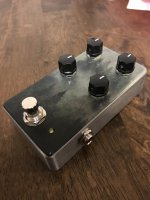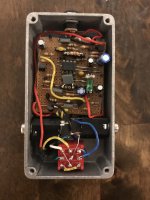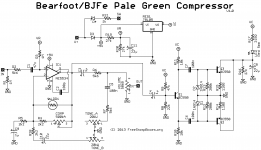Made this pale green compressor circuit from the tagboard layout. Sounds great, though a little bit “clicky” when the comp is turned up. This may have to do some with the led/ldr combo. Anyway, I added an attack knob described on the fsb thread, which is similar to how the EQD Warden is implemented. I can add details if anyone’s interested.
You are using an out of date browser. It may not display this or other websites correctly.
You should upgrade or use an alternative browser.
You should upgrade or use an alternative browser.
Pale Green Comp
- Thread starter phi1
- Start date
mjh36
Well-known member
This is the one I saw is it the same?
Compressors - BJFE Pale Green Compressor
BJFE Pale Green Compressor. here's my verified layout for the BJFE Pale Green Compressor. and BTW, it sounds great.
guitar-fx-layouts.42897.x6.nabble.com
Hi! I'll try to answer your questions.
The page you linked is from the forum of that site. They moved this particular layout to the main page. The forum has a few things the main page doesn't, but in general the main page is more reliable.

 tagboardeffects.blogspot.com
tagboardeffects.blogspot.com
Most (including me) prefer building on PCBs since it's much more convenient. I use tagboard at times when I don't see a PCB available, or if I want to rearrange parts for a mod, or if I don't want to wait for shipping a pcb.
I'd recommend reading through this build guide before building a vero project. Also, the pale green is pretty involved, I wouldn't necessarily recommend it as a first vero project.

 tagboardeffects.blogspot.com
tagboardeffects.blogspot.com
For the LED/LDR, that layout recommends a vactrol (NSL32), which is an LED & LDR manufactured in a convenient sealed package. I just went with a green LED and LDR, and bent them 90deg to be facing each other. I rearranged a few things to they'd be right next to each other.
Using heat shrink is nice because it blocks out any light that would affect the LDR (especially good for out of the box testing). It can also provide support to physically hold the parts together. For this build, I didn't use heat shrink. Once in the enclosure, it's a dark environment anyway, and since they're so close they didn't need any help staying together physically. For LED/LDR projects from PedalPCB, he always puts the LED & LDR right next to each other so you don't really need to use heat shrink, just bend the LDRs to face the LED.
Happy to answer any other questions.
The page you linked is from the forum of that site. They moved this particular layout to the main page. The forum has a few things the main page doesn't, but in general the main page is more reliable.
BJFE Pale Green Compressor
Collection of vero (stripboard) & tagboard layouts for 100s of popular guitar effects, with over 1000 verified designs. DIY your own boutique effects!
Most (including me) prefer building on PCBs since it's much more convenient. I use tagboard at times when I don't see a PCB available, or if I want to rearrange parts for a mod, or if I don't want to wait for shipping a pcb.
I'd recommend reading through this build guide before building a vero project. Also, the pale green is pretty involved, I wouldn't necessarily recommend it as a first vero project.

Greeny's Vero Build Guide
Collection of vero (stripboard) & tagboard layouts for 100s of popular guitar effects, with over 1000 verified designs. DIY your own boutique effects!
For the LED/LDR, that layout recommends a vactrol (NSL32), which is an LED & LDR manufactured in a convenient sealed package. I just went with a green LED and LDR, and bent them 90deg to be facing each other. I rearranged a few things to they'd be right next to each other.
Using heat shrink is nice because it blocks out any light that would affect the LDR (especially good for out of the box testing). It can also provide support to physically hold the parts together. For this build, I didn't use heat shrink. Once in the enclosure, it's a dark environment anyway, and since they're so close they didn't need any help staying together physically. For LED/LDR projects from PedalPCB, he always puts the LED & LDR right next to each other so you don't really need to use heat shrink, just bend the LDRs to face the LED.
Happy to answer any other questions.
Chuck D. Bones
Circuit Wizard
Nice artwork, very subtle.
To deal with the "clickiness," you could try rewiring the stomp switch so that guitar signal always goes to the board, even when it's in bypass. That way, the comp is constantly tracking the signal amplitude. When the switch is wired to kill the input in bypass, the comp automatically turns the gain all the way up because there's no signal. This can cause popping when you switch from bypass to active.
To deal with the "clickiness," you could try rewiring the stomp switch so that guitar signal always goes to the board, even when it's in bypass. That way, the comp is constantly tracking the signal amplitude. When the switch is wired to kill the input in bypass, the comp automatically turns the gain all the way up because there's no signal. This can cause popping when you switch from bypass to active.
Thanks man. Sorry, my description wasn’t very good, I was talking about the actual attack of the picking note having a ‘clicky’ quality at high compression levels, not when switching. That’s why I thought the attack control to increase attack time might help. Maybe at some point I’ll build a delegate (with your mods) to really dig in to tweaking an optical comp. but, as a fan of bjf designs, I really enjoy having this in the collection.
Chuck D. Bones
Circuit Wizard
OK, I follow. The Delegate does this also, to a degree at high compression swettings. There are two possible causes, both related to the LDR. LDRs do not respond fast enough to limit the initial transient when we hit the strings hard, so a little pop at high comp setting is normal. There is a lot of variability in LDRs and it's possible that the one you have won't go low enough in resistance. You could try increasing the 1K resistor that connects to one end of the LDR. That change will reduce the max gain available, but will also increase the amount of compression the LDR can provide. If you have more LDRs, try measuring their resistance with a desk lamp shining on them.
Chuck D. Bones
Circuit Wizard
Can you post a schematic of what you built, with ref des? I have one I downloaded, but I don't know if that matches your build.
Chuck D. Bones
Circuit Wizard
Thanks for providing the schematic.
That's the resistor to which I was referring. The schematic I have is similar, but in that one R5 is 1K and R18 isn't there.
That's the resistor to which I was referring. The schematic I have is similar, but in that one R5 is 1K and R18 isn't there.
Chuck D. Bones
Circuit Wizard
OK, one more question...
Did you use a dual W20K pot as shown in the sch or a single W20K?
Did you use a dual W20K pot as shown in the sch or a single W20K?
Haha yeah I actually omitted the bass side and just used a single 20k for the treble roll off.
the bass Response seems already Ok for guitar because of R5 & C9 (cutoff = 72Hz). Sounds fine To me too. My initial plan was separate bass and treble knobs, and I planned to experiment with C9 to get a meaningful bass cut with the bass knob down. I socketed C9.
after building the circuit and testing, I decided to go with the attack knob (I really wanted To keep a 4 knob layout haha). So I decided a bass knob wasn’t really needed. So, R18 and C10 aren’t doing anything now. I don’t see a reason to cut bass on a compressor, I suppose unless you wanted to use it as a treble booster. I should probably go back and up C9 so that it’s good to go for bass guitar too.
the bass Response seems already Ok for guitar because of R5 & C9 (cutoff = 72Hz). Sounds fine To me too. My initial plan was separate bass and treble knobs, and I planned to experiment with C9 to get a meaningful bass cut with the bass knob down. I socketed C9.
after building the circuit and testing, I decided to go with the attack knob (I really wanted To keep a 4 knob layout haha). So I decided a bass knob wasn’t really needed. So, R18 and C10 aren’t doing anything now. I don’t see a reason to cut bass on a compressor, I suppose unless you wanted to use it as a treble booster. I should probably go back and up C9 so that it’s good to go for bass guitar too.
Chuck D. Bones
Circuit Wizard
With C9 = 1uF and R = 2.2K, the bass is rolled-off below 72Hz. Bumping C9 up to 2.2uF moves the cutoff freq down to 33Hz.
Where exactly did you connect the ATTACK pot?
Where exactly did you connect the ATTACK pot?
Last edited:
Right, We’re on the same page with the bass roll off, I could have been clearer about where I got the 72Hz from.
My attack knob is a 5kB (value decided after some experimenting) between collectors of Q2/Q3, and the junction of R16, C8, and led. This was suggested on the fsb thread last page, but I’m not sure if it’s an optimal location, since the delegate puts the attack control on the junction of the emitters.
I’m open for suggestions on improving, or at least learning. It seems to me that the attack knob adds more resistance in the path of the LED to ground, (on both mine and the delegate). This would affect how bright the led is, right? Does it interact with C8 to affect the time constant of that filter (or in other words, fill up C8 more slowly)?
My attack knob is a 5kB (value decided after some experimenting) between collectors of Q2/Q3, and the junction of R16, C8, and led. This was suggested on the fsb thread last page, but I’m not sure if it’s an optimal location, since the delegate puts the attack control on the junction of the emitters.
I’m open for suggestions on improving, or at least learning. It seems to me that the attack knob adds more resistance in the path of the LED to ground, (on both mine and the delegate). This would affect how bright the led is, right? Does it interact with C8 to affect the time constant of that filter (or in other words, fill up C8 more slowly)?
Chuck D. Bones
Circuit Wizard
It seems to me that the attack knob adds more resistance in the path of the LED to ground, (on both mine and the delegate). This would affect how bright the led is, right? Does it interact with C8 to affect the time constant of that filter (or in other words, fill up C8 more slowly)?
The ATTACK control does both. The LED is inside a feedback loop that throttle's the brightness to achieved the desired volume. The ATTACK control limits the maximum brightness, but the control loop usually keeps the brightness well below that limit. More importantly, the ATTACK control limits how quickly the control loop can ramp up the LED's brightness and turn down the gain in response to meat hitting steel. Because it takes time to charge or discharge C8 and the LDR response time is fairly slow, there is a lag in the control loop that can cause the LED brightness to overshoot. That overshoot and eventual recovery creates a volume drop immediately after the note attack that is sometimes described as "breathing." Breathing more pronounced at high COMPRESSION settings. By slowing down the rate at which the LED's brightness increases, the ATTACK control reduces the overshoot but also limits how much the gain is reduced. It's a balancing act between the attack being slow enough but not too slow. The ATTACK & COMPRESSION controls interact. At high COMPRESSION settings, the ATTACK setting becomes more sensitive. Yeah, it's complicated.
Similar threads
- Replies
- 1
- Views
- 145
- Replies
- 25
- Views
- 2K





